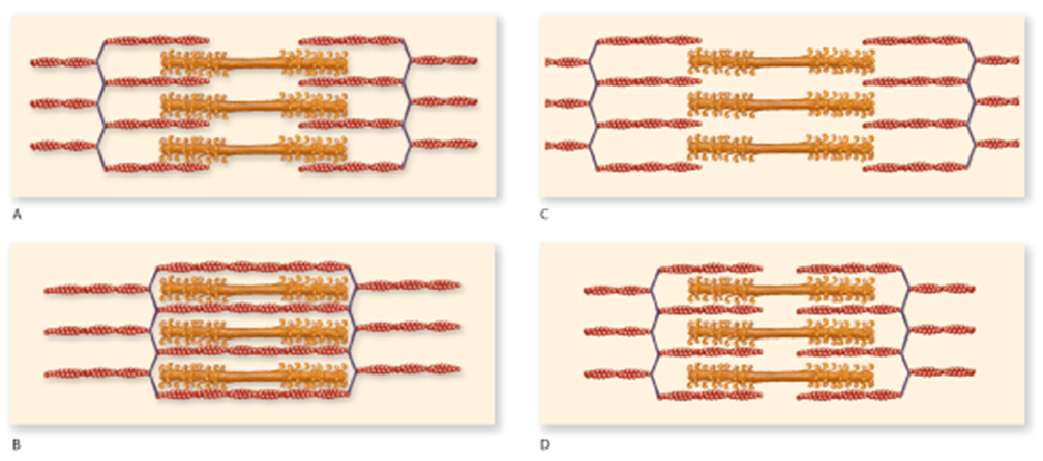According to the figure, which one represents the muscle in an optimal condition for a strong contraction?

A. A
B. B
C. C
D. D
Clarify Question
· What is the key concept addressed by the question?
· What type of thinking is required?
Gather Content
· What do you know about conditions necessary for a strong muscle contraction? What other information is related to the question?
Choose Answer
· Given what you now know, what information is most likely to produce the correct answer?
Reflect on Process
· Did your problem-solving process lead you to the correct answer? If not, where did the process break down or lead you astray? How can you revise your approach to produce a more desirable result?
A. A
Clarify Question
· What is the key concept addressed by the question?
o The question asks about conditions for a strong muscle contraction.
· What type of thinking is required?
o You are being asked to analyze which conditions would allow a strong muscle contraction.
Gather Content
· What do you know about conditions necessary for a strong muscle contraction? What other information is related to the question?
o A contraction occurs when myosin heads bend, pulling the myosin along the actin. The more myosin and actin cross bridges the stronger the potential contraction. If the actin and myosin filaments have already slid across each other then they cannot slide much more and produce a strong contraction.
Choose Answer
· Given what you now know, what information is most likely to produce the correct answer?
o Panel A is the correct answer, because all of the myosin head groups are paired with an actin filament but the filaments have not already contracted. Panel C has very few myosin-actin cross bridges and will not be able to generate a powerful contraction. Panels B and D have already fully or partially contracted and will not be able to contract as much as the myofibril in panel A.
Reflect on Process
· Did your problem-solving process lead you to the correct answer? If not, where did the process break down or lead you astray? How can you revise your approach to produce a more desirable result?
o This question asked you to analyze which conditions would allow a strong muscle contraction. If you got the correct answer, great job! If you got an incorrect answer, where did the process break down? Did you think that panel C would be able to create more force because the filaments were furthest apart? Did you think that B or D would generate a powerful contraction even though they were already partially or fully contracted?
You might also like to view...
Interaction of a pathogen-associated molecular pattern (PAMP) with a pattern recognition receptor (PRR) results in
A) formation of transmembrane pores that cause cell lysis. B) transmembrane signal transduction that initiates transcription of genes involved in phagocytosis, inflammation, and pathogen killing. C) molecular activation of the adaptive immune system. D) a superantigen reaction that can cause septic shock.
Assume that a dihybrid F2 ratio, resulting from epistasis, was 15:1. If a double heterozygote is crossed with the fully recessive type, what phenotypic ratio is expected among the offspring?
What will be an ideal response?
The nitrogenous waste material of an embryo that accumulates inside the eggshell of a bird or reptile is
A. urea. B. amino acid. C. uric acid. D. ammonia. E. uracil.
O157:H7, a pathogenic strain of E. coli, has more than 1,000 genes that are not present in the harmless strain K-12. Many of these genes are associated with phage DNA in the bacterial chromosome. These observations suggest that __________.
a. this virulent strain has many more R plasmids than does the harmless strain and is resistant to almost all antibiotics b. at least some of these genes were acquired through phage-mediated horizontal gene transfer c. at least some of these genes were acquired through phage-mediated horizontal gene transfer, and these genes were not acquired through conjugation with K-12 d. these genes were not acquired through conjugation with K-12 e. most of these novel genes must be a result of mutations and short generation times